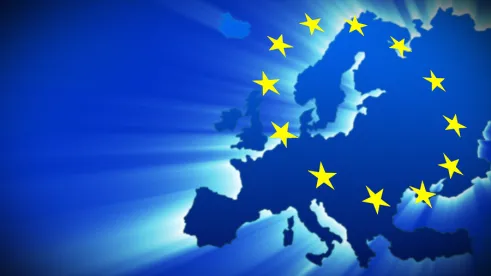Brexit and International Policy Developments
The usual quiet of Brussels’ August recess was disturbed by the arrival, in the middle of the month, of a flurry of position papers from the British government.
The two most important of these dealt with the EU’s customs union and the border between Northern Ireland and the republic of Ireland. According to the customs union paper, the UK would leave the existing EU customs union, maintain a “close association” for a limited period, and then seek either a new customs border with the EU, with border “facilitations” to reduce and remove trade barriers, or a “new customs partnership,” aligning the EU and the British approach to customs. This would allow the suppression of the customs border between Northern Ireland and the republic of Ireland, thereby solving the Irish border problem. In the interim, Britain would seek new trade agreements with third countries.
These proposals were not well received in Brussels. The EU side saw the paper on the customs union as a “surrealistic” exercise, since it is not possible to leave the customs union and get back to it after having concluded separate trade agreement with third parties. Another reason for criticism was that the papers did not respect the “sequencing” that had been agreed – first settling the past, and only then discussing the future relationship. Furthermore, no position paper was forthcoming from London on the financial settlement – though this was supposed to be the main topic of the third round of the talks planned for the last week of August.
In this context, a breakthrough at this session was obviously not possible. The discussion was tense; some technical agreements were reached, some possible compromises explored informally, but as was noted at the end of the session by Michel Barnier, the EU negotiator, “We haven’t noted any decisive progress on the principal subjects.”
On the financial settlement, the British side continued to claim that there is no legal obligation for the UK to contribute anything after the exit. The British negotiator David Davis conceded that there might be “a moral obligation” to do so, but hinted that this should better be discussed “in the spirit of continuing the partnership with the EU” – i.e., alongside the future relationship.
The current deadlock will have obvious consequences on the timing of the negotiations. The expectation was indeed that the second phase could be opened on the occasion of the European Council of October 19 to 20. This will now probably not happen. As Barnier added in his concluding remarks: “At the current state of progress, we are far from assessing that progress has been sufficient to be able to recommend to the European Council that it engage in discussions on the future relationship”.
The impasse on the financial settlement and the absence of a clear UK position on the future relationship will probably be discussed intensely on the occasion of the Conservative Party Conference on October 4, but any clarity will come too late to make “sufficient progress” in time for the October European Council.
Meanwhile, officials in London and Brussels continue to reflect on a way out of the tricky Article 50 two-year deadline, through a “transition period”. The UK’s official position continues to be that the UK will leave the single market and the customs union immediately at the end of the two-year notice period, and “get back control” of immigration. However, the discussion about a transition period is also used by UK politicians who are not enthusiastic about Brexit to promote a “softer” outcome. Some see it as a way to demonstrate the advantages of the status of member of the European Economic Area (“EEA”) by adopting that model (at least) for the transition period; others look already to the 2022 general election, and see the transition period as a way to keep the UK’s options open until then.
An important development in this context is the new position on Brexit expressed by Keir Starmer, the Labour Shadow Secretary for Exiting the EU, in an article at the end of August. He advocated “a transitional deal that maintains the same basic terms that we currently enjoy with the EU”; that transition, he added, should be “as short as possible but as long as necessary”.
Meanwhile, a draft UK Home Office position paper leaked to the Guardian on September 5 suggested that the May government would seek to end the free movement of labor from the EU into the UK immediately after Brexit. The plan aims to reduce the number of low skilled migrants by giving them residence permits of a maximum two years, while giving longer term permits for “highly skilled occupations”. The position paper also suggests restricting the right of EU citizens to bring over family members – a highly sensitive issue for the EU 27.
Tech and Digital Single Market Policies
On September 13, 2017, European Commission President Jean-Claude Juncker announced the EU Cybersecurity Strategy in his State of the European Union speech. President Juncker said “Cyber-attacks can be more dangerous to the stability of democracies and economies than guns and tanks. […] Today, the Commission is proposing new tools, including a European Cybersecurity Agency, to help defend us.” As part of EU Cybersecurity Strategy, on the same day the European Commission published the following documents:
-
A report on the evaluation of the European Union Agency for Network and Information Security (“ENISA”, see here). According to the report, the evaluation of ENISA activities suggests that there is a need for an EU Agency organized on a cross-sectoral basis with a strong mandate. As a result of such a conclusion, the European Commission proposed a new Regulation (see here) to enhance ENISA’s responsibilities and capabilities.
-
A Communication (see here) outlining how to effectively implement the Network and Information Security Directive (see here), and which is designed to improve the security of network and information systems across the EU.
-
A report (see here) assessing the extent to which the Member States have taken the necessary measures in order to comply with Directive 2013/40/EU on attacks against information systems (see here).
On September 13, 2017 the European Commission also published a proposed regulation on a framework for the free flow of non-personal data in the European Union (see here). According to the proposal, its general policy objective is to achieve a more competitive and integrated internal market for data storage and other processing services and activities. It would do so by: (a) improving the mobility of non-personal data across borders in the single market; and (b) making it easier for professional users of data storage or other processing services to switch service providers and to port data; whilst(c) ensuring that the powers of competent authorities to request and receive access to data for regulatory control purposes remain unaffected.
On September 5, 2017 the European Court of Human Rights issued a decision in the Bărbulescu case. This case could to set an important precedent on employers’ rights to monitor their employee’s work emails and other means of electronic communications. Mr. Bogdan Bărbulescu, a Romanian national, was fired from a Romanian company for using his professional Yahoo messenger account for private communications. According to the Council of Europe’s Grand Chamber, his employer, by accessing his electronic communications, violated his right to privacy and breached the right to private life which is protected by the European Convention of Human Rights.
The Court also noted that, “although it was questionable whether Mr. Bărbulescu could have had a reasonable expectation of privacy in view of his employer’s restrictive regulations on internet use, of which he had been informed, an employer’s instructions could not reduce private social life in the workplace to zero. The right to respect for private life and for the privacy of correspondence continued to exist, even if these might be restricted in so far as necessary.” See the judgment here, a press release here, and commentary here.
On August 24, 2017 the UK Government published a position paper on shared approaches to data protection, entitled “The exchange and protection of personal data – a future partnership paper” (see here). The paper provides that an EU-UK model for protecting and exchanging personal data which allows free flows of data to continue is essential. It further calls for ongoing regulatory cooperation and certainty for businesses as well as other stakeholders.
Matt Hancock, Minister of State for Digital, stated that “a strong future data relationship between the UK and EU, based on aligned data protection rules, is in our mutual interest.” He added that such a deal would have to “respects UK sovereignty, including the UK’s ability to protect the security of its citizens and its ability to maintain and develop its position as a leader in data protection.”
However, the paper also raises several questions. Firstly, the UK wants the British data protection authority (the Information Commissioner’s Office), to have a role in the EU’s decision-making on data protection laws and complaints. Secondly, the UK seeks a transition window in which the EU would acknowledge the strength of the UK’s data protection rules to allow for the continued transfer of data. Thirdly, the position paper makes no mention of the Investigatory Powers Act, a controversial surveillance law that has been deemed as excessive and unnecessary by the Court of Justice of the European Union in the past – and which could therefore put EU recognition of UK data protection rules at risk after Brexit.
Looking ahead, the European Commission and the U.S. administration are due to meet in September for the first annual review of the EU-U.S. Privacy Shield. The review procedure will begin in the second half of September, during the week of September 18, 2017, when Commissioner Věra Jourová will conduct the political opening of the review in Washington, D.C. Once the talks have concluded, the Commission will present its report evaluating the Privacy Shield’s first year of operation in light of these discussions.
Communication and Media Policies
On August 29, 2017, Digital Commissioner Mariya Gabriel said she wants to hold a public consultation and create a high-level expert group on fake news. She added that Europe, and not just individual member countries, needs tools to tackle fake news. Commissioner Gabriel also said that she will need the next two or three months to build a basis for this consultation. The European Commission’s communication on flagging and removing illegal online content is expected on September 27, 2017.
In addition, the Polish government could soon have rules in place for internet service providers and on how they handle fake news. Moreover, it will seek to oblige internet service providers to follow Polish law regardless of where they are based. The draft is expected in September, 2017.
Energy and Environment Policies
By the end of September, the European Commission is expected to bring forward a proposal (see here) that would ban the use in cosmetic products of numerous substances classified as Category 1 or 2 carcinogens, mutagens and toxic to reproduction substances (“CMRs”). The proposed so-called “Omnibus Act” would ban the CMRs listed therein by including them in Annex II to Regulation 1223/2009 on cosmetic products (the “Cosmetics Regulation”, see here).
The Omnibus Act would ban the use in cosmetic products of substances including formaldehyde, chloracetamide, and perboric acid and sodium perborate compounds. The proposal confirms that an amendment to Annex II to the Cosmetics Regulation is necessary before the use of a CMR in cosmetics is banned – thus exposing the Commission’s reversal of its initial view that substances are banned in cosmetic products as soon as they are classified as Category 1 or 2 CMRs, without the need for an amendment to Annex II.
In response to a public consultation that the Commission held between June 26 and July 24, 2017, industry criticized the proposed Omnibus Act strongly (see here) for banning several substances without correctly and thoroughly applying the exception criteria of Article 15(2) of the Cosmetics Regulation.
Member State representatives are expected to vote on the proposal in October or November 2017 by qualified majority. After a positive vote of the Member State representatives, the Council and European Parliament will have three months to review the proposal and potentially oppose it on limited grounds. The Omnibus Act could be adopted by early 2018 and the ban on the listed substances could be in force by early February 2018. The current draft proposal does not have a transitional period; the ban could therefore apply immediately to cosmetic products that are on the shelf of distributors and retailers.
Internal Market and Financial Services Policies
On August 11, the European Commission adopted a Commission Implementing Regulation that stipulates a standardized presentation format for the information document accompanying insurance products, such as car or house insurances. In order to facilitate consumers’ understanding of the content of an insurance product, the Regulation provides for clear headings, including “What is insured?”, or “When and how do I pay?”, as well as the use of icons. The Regulation was based on a technical standard developed by the European Insurance and Occupational Pensions Authority, and implements a provision of the Directive (EU) 2016/97 on insurance distribution. Additional implementing acts on product oversight and governance requirements for insurance undertakings and distributors, as well as information requirements for insurance-based investment products, are currently under consideration. Directive (EU) 2016/97 must be implemented by February 23, 2018. See the Commission Implementing Regulation on the information document accompanying insurance products here, and the underlying Directive (EU) 2016/97 on insurance distribution here.
On August 15, Germany’s Constitutional Court in Karlsruhe refused to hear a case relating to the €2.3 trillion asset purchase scheme of the European Central Bank (“ECB”), the Public Sector Purchase Programme (“PSPP”). The court instead referred the case to the Court of Justice of the European Union, stating that they saw “significant reasons” to suggest that the ECB overstepped its monetary policy mandate when it commenced the scheme in 2015. The scheme, started in 2015, saw the ECB buy up government debt in order to inject liquidity into the Eurozone, and seek to improve its economic recovery. See further information here.
Life Sciences and Healthcare Policies
On August 23, the European Commission, the European Medicines Agency (“EMA”) and the U.S. Food and Drug Administration struck a deal to allow the sharing of non-public commercially confidential information and the full reports of drug manufacturing inspections. This derives from the agreement between the U.S. and the EU on the mutual recognition of the inspections of human drug manufacturers performed by the authorities of their respective territories, concluded in March 2017. This agreement is aimed at facilitating the work of drug regulators on either side of the Atlantic, and at enhancing controls on pharmaceutical companies. See more information here, the Commission commitment here, and the FDA commitment here.
On August 1, the EMA published a new paper in its Brexit series. The paper outlined the EMA’s business continuity plan. The EMA’s plan is aimed at protecting the agency’s ability to protect human and animal health post-Brexit. The EMA seeks to avoid any disruption in drug assessment post-Brexit and to ensure that patients still benefit from quality treatment. This plan sets out the EMA’s priorities for a smooth transition post-Brexit, and is likely to be updated on a regular basis. See the press release here, and more information here.
In late July, the EMA published a revised version of its “Guideline on first-in-human clinical trials”. The Guideline was revised to help industry identify and mitigate the risks for clinical trial participants. It takes account of the evolution in clinical trials of the last decade, and addresses various new considerations, such as single and multiple ascending doses, food interactions, and different age groups. In particular, it provides guidance on the starting dosage and criteria for calculating the maximum dosage a treatment may reach as a result of an escalation scale. The new guideline is of importance for pharmaceutical companies, as it will impact how clinical trials are performed. See the revised Guideline here.
Trade Policy and Sanctions
In a policy paper dated July 29, 2017, Germany, France and Italy recalled their initiative of February this year, aimed at having the EU play a bigger role in protecting Europe’s technologically advanced companies from what they see as politically motivated Chinese acquisitions – proposals sometimes termed “European CIFIUS”, after the similar U.S. mechanism. The three countries propose that the European Commission should determine whether acquisitions are steered by a foreign state’s political objectives rather than market forces. In such cases, Member States would be granted greater leeway to reject such proposed investments.
As outlined in last month’s newsletter, EU Commission President Jean-Claude Juncker announced this initiative in his State of the Union address, today, September 13. Concrete proposals are expected to be released in the coming days.
British Prime Minister Theresa May travelled to Japan in the last week of August. She obtained a pledge from the Japanese government to “work quickly to establish a new economic partnership between Japan and the UK based on the final terms of the Economic Partnership Agreement”, the political agreement signed in July between the EU and Japan. However, the trip also highlighted the anxiety of Japanese companies for the future of their UK investments, which could be impacted by the withdrawal of the UK from the EU internal market. Japanese Prime Minister Shinzō Abe, during a joint press conference with Mrs. May in Tokyo, repeatedly called for a “transparent and predictable” Brexit process.
Francis Maude, Atli Stannard, Lucas Falco, Kasia Lasinka, and Bruno Standaert also contributed to this article.









 />i
/>i

